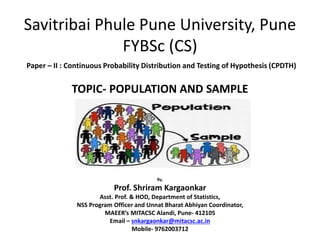
Population and Sample CPDTH.pptx
- 1. Savitribai Phule Pune University, Pune FYBSc (CS) Paper – II : Continuous Probability Distribution and Testing of Hypothesis (CPDTH) TOPIC- POPULATION AND SAMPLE By, Prof. Shriram Kargaonkar Asst. Prof. & HOD, Department of Statistics, NSS Program Officer and Unnat Bharat Abhiyan Coordinator, MAEER’s MITACSC Alandi, Pune- 412105 Email – snkargaonkar@mitacsc.ac.in Mobile- 9762003712
- 2. Introduction • In Statistics, data plays an essential role in deciding the validity of the outcome. • The data being used must be relevant, correct, and representative of all classes. • While more data is good to get impartial results, it is crucial to make sure that the data collected is suitable for the problem at hand. • In this lecture, the concept of Population and Sample will be explained in the simplest way.
- 3. Population The totality of all objects under study. The Collection of all objects under study. Objects can be can be a group of individuals, a set of items, etc. It makes up the data pool for a study.
- 4. Population Examples 1) Number of students appearing for the FYBSc (CS) exam. 2) Total number of Students appearing for a particular exam in a particular city, district, state or country. 3) Total number of people in the country. 4) Total number of items manufactured by the company. 5) Total number of diabetic patients in the city. 6) Number of stars in the sky 7) Number of leaves on the tree 8) Total blood in the body 9) Number of students in the class. 10) Number of industries/companies/business in a particular region.
- 5. Types of Population There are different types of population. They are: Finite Population: Countable / Finite number of elements Infinite Population: Uncountable / infinite number of elements. Existent Population: population of concrete individuals/ available in solid form Hypothetical Population: whose unit is not available in solid form
- 6. Sample It is the representative part of the population. A sample refers to a smaller, manageable version of a larger group. It is a subset containing the characteristics of a larger population. Samples are used in statistical testing when population sizes are too large for the test to include all possible members or observations. In other words, it is a portion, part, or fraction of the whole group, and acts as a subset of the population. Sample Examples 1) Selecting a handful of grains to check the quality of the grain to make decision of purchasing or nor. 2) To check the blood group, just few drops are taken instead of whole blood. 3) To select appropriate number of diabetic patients among many to conduct a research based on them. 4) To select few students among entire class for question answer session during the class. 5) Selecting 10 digits randomly out of 1 to 100. 6) Selecting few items among all the manufactured items to decide the quality of the product etc.
- 8. Case Studies to understand the “sample” 1) Use of Social Media among youths 2) Opinion about politics in Maharashtra. 3) Financial Awareness among people in rural area. 4) Opinion of students regarding mode of examination. 5) Mode of transport of students 6) Opinion of preference of mobile phone brands among people etc....
- 12. Types of Simple Random Sampling (SRS) Simple Random Sampling With Replacement (SRSWR) Simple Random Sampling Without Replacement (SRSWOR) Items selected at every draw, is replaced back in the population If there are ‘N’ items in the population then at every draw, every item has the equal chance of being selected in the sample i.e. 1/N Items selected at every draw, is not replaced back in the population and it is kept aside. If there are ‘N’ items in the population then at every draw, probability of getting selected changes i.e. 1/N, 1/(N-1) , ....etc.
- 14. Cluster Sampling It is a method where the researchers divide the entire population into sections or clusters that represent a population. It Contains heterogeneous population. Clusters are identified and included in a sample based on demographic parameters like age, sex, location, etc. This makes it very simple for a survey creator to derive effective inference from the feedback.
- 15. Systematic Sampling Method Researchers use the Systematic Sampling Method to choose the sample members of a population at regular intervals. It requires the selection of a starting point for the sample and sample size that can be repeated at regular intervals. This type of sampling method has a predefined range, and hence this sampling technique is the least time-consuming.
- 17. Types of Non-Probability Sampling 1) Convenience Sampling. The selection of these cases is due to the accessibility of the inclusion of the element and the proximity of this subject with the researcher. It is useful when it is necessary to have information quickly and inexpensively, regardless of whether it is generalizable to the population. When a person approaches us in the street to fill out a survey, it is convenience sampling. 2) Snowball Sampling. Snowball sampling — also known as referral sampling — is carried out on populations in which their individuals are not known, or it is tough to access them. So each subject studied proposes others, in such a way that generates a cumulative effect of observations. It is widely used in public policy and social studies. This is the most common system for finding information on organized crime. 3) Quota Sampling. Quota sampling is based on selecting the sample after dividing the population into strata. The subjects within each group are chosen by non-probabilistic methods. Furthermore, the number of elements selected is due to an arbitrary number (quotas) from which a sample relatively proportional to the population is built.